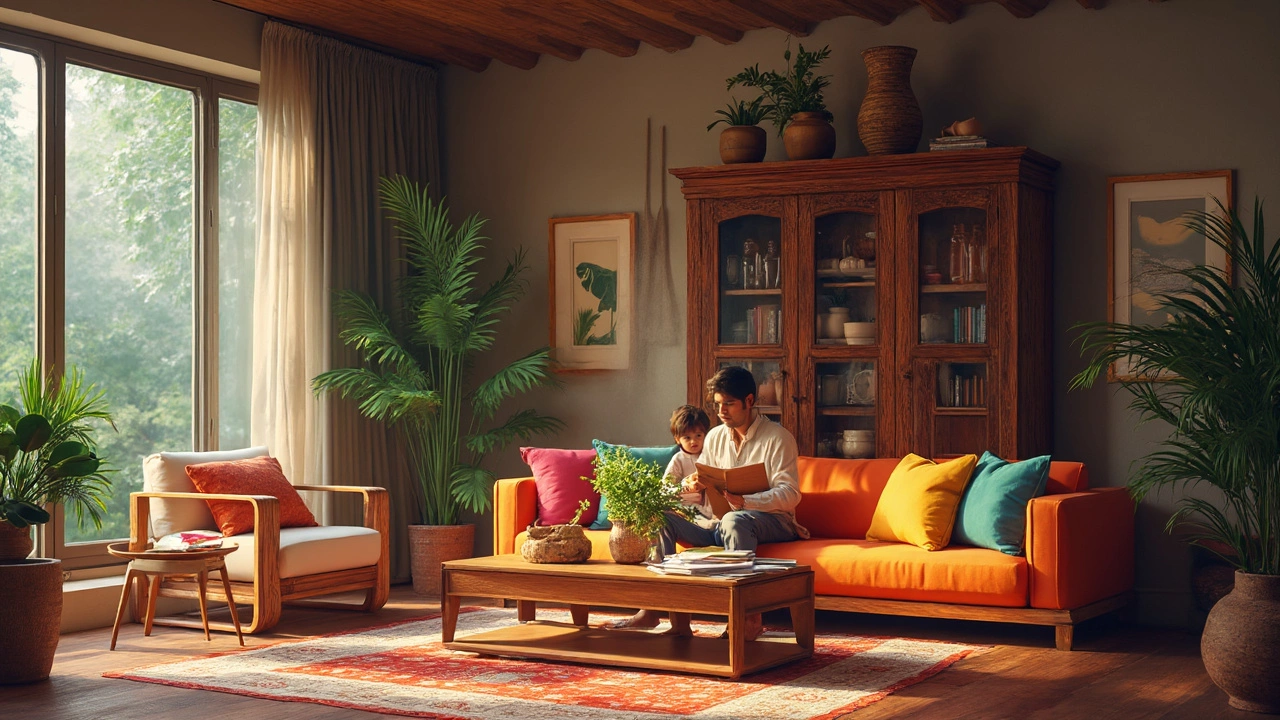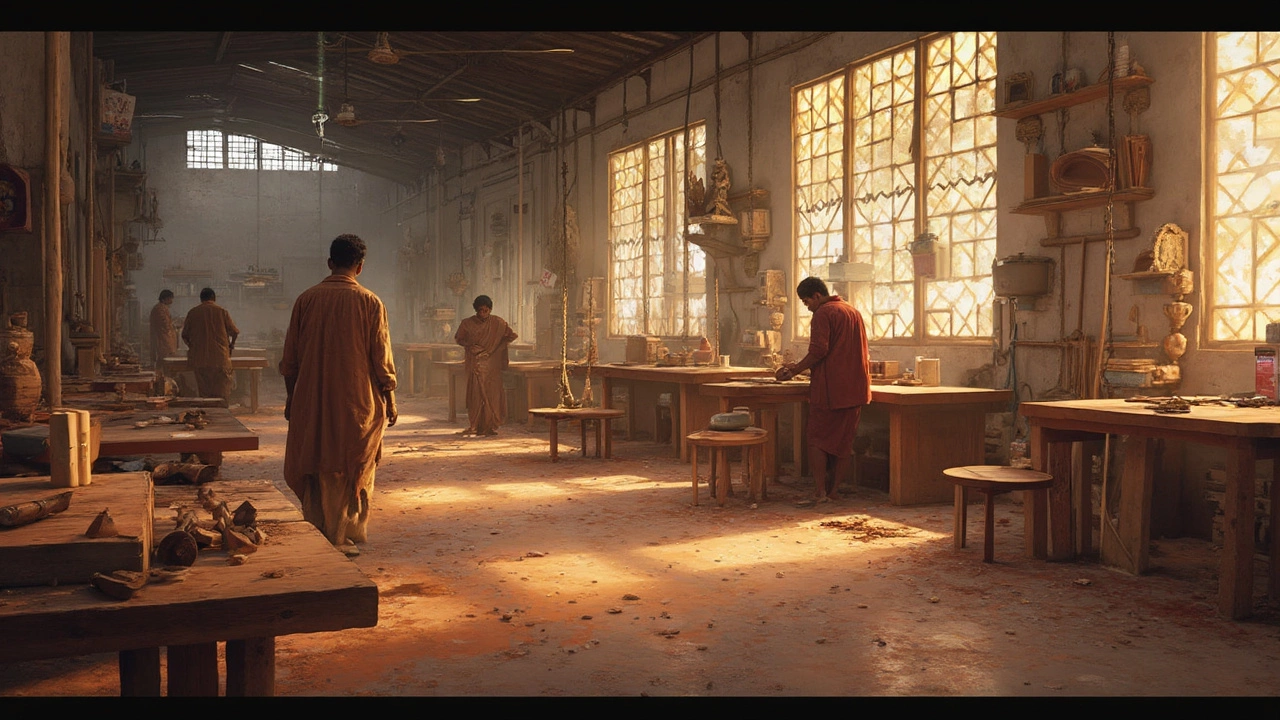Picking the right wood is where good furniture starts. In India, you can’t just go with what looks fancy—humidity, heat, and dust can kill a nice-looking table in months. Ever bought a cheap “solid wood” bed and ended up with warped frames after one monsoon? Yeah, that’s not a fun surprise to deal with.
Most folks stick to tried-and-tested options that actually work in Indian homes. Teak and sheesham (you’ve probably heard both at every furniture shop) top the list, but there’s more variety now—like mango wood, which is cheaper and getting popular. Plus, engineered stuff like plywood can be a lifesaver for kitchen cabinets or shelves that get a rough deal.
If you’re weighing your options or just want your next sofa to survive longer than Max’s favorite chew toy, knowing what’s inside the frame makes a massive difference. Once you get why Indian manufacturers pick certain woods, you’ll stop falling for shiny surface polish and start spotting real value.
- How Indian Climate Shapes Wood Choices
- Teak: The Classic All-Rounder
- Sheesham and Mango: Popular Indian Alternatives
- Plywood, MDF, and Engineered Wood: Good Deals or Hidden Costs?
- Tips for Spotting Quality Wood Furniture
- Making Your Investment Last: Simple Care Hacks
How Indian Climate Shapes Wood Choices
Here’s the blunt truth: India’s weather can ruin furniture if you pick the wrong wood. Between crazy hot summers, heavy monsoons, and dry spells in other regions, your furniture has to survive real ups and downs. The changes in temperature and humidity make some woods expand, contract, or even crack wide open. If your wooden chair is literally coming apart at the seams, blame the climate first—it’s rougher here than in Europe or the US.
Coastal areas like Mumbai and Chennai mean high humidity all year. In these places, wood soaks up moisture like a sponge, leading to swelling or fungus. That’s why folks here swear by teak, since it naturally resists water and termites. On the flip side, cities up north—think Delhi or Jaipur—see sizzling dry heat and chilly winters. Here, wood can lose moisture and shrink or split. Sheesham and mango woods handle these changes better than softer woods.
An often-overlooked detail: real best wood furniture makers season their timber to match local climates. ‘Seasoning’ means drying the wood properly before it’s made into furniture. This process is super important—otherwise, even top-quality teak can warp or crack over time.
Here’s what really matters when choosing wood for Indian homes:
- Humidity resistance: Teak and sheesham don’t puff up or rot easy. Stay away from unseasoned pine or softwoods in moist regions.
- Termite protection: Teak’s natural oils act like bug repellent. Other hardwoods, if treated with the right chemicals or finishes, do fine too.
- Flexibility: Hardwoods like sheesham and mango adapt to temperature swings better than cheap particle board or unseasoned wood.
Just because something looks shiny in the showroom doesn’t mean it can survive a Mumbai monsoon or a Delhi summer. Always ask what wood was used, where it came from, and—if you want your money’s worth—whether it was seasoned to handle Indian weather.
Teak: The Classic All-Rounder
When it comes to making strong, long-lasting furniture in India, teak is the big boss. There’s a reason your grandparents’ old teak almirah still looks good after decades—it’s just built different. This wood has natural oils inside that make it tough against rot, termites, rain, and sun. That’s why companies and carpenters count on it for both indoor and outdoor stuff.
Teak has a warm golden brown shade that actually gets better with age—unlike most woods, it won’t lose color or get patchy after years of use. In India, a lot of teak comes from forests in Kerala, Central India, and Burma (Myanmar teak is still considered the gold standard in luxury furniture circles). The grain is straight and even, so if you hate weird-looking, knotty surfaces, you’ll love this wood.
But here’s the catch: teak is pricey. It’s usually about twice as costly as sheesham, and way more than mango or engineered wood. Still, folks spend the extra cash because it’s an investment. If you’re wondering how it stacks up on key points, check out this quick comparison:
| Wood Type | Durability | Termite Resistance | Estimated Price (per cubic foot, 2025) |
|---|---|---|---|
| Teak | Excellent | Very High | ₹4,000 - ₹7,500 |
| Sheesham | Very Good | High | ₹2,500 - ₹3,800 |
| Mango | Medium | Good | ₹1,800 - ₹2,400 |
When shopping, always check if the furniture is made from solid teak or a mix with cheaper woods. Some manufacturers try to cut costs by just using thin teak sheets on the outside. Knock on the wood—if it feels heavy and doesn’t bounce, that’s a good sign. Full teak furniture also ages well and won’t fall apart in humid cities like Mumbai or Chennai, where regular wood cracks.
So if you can stretch your budget, choose teak for beds, dining tables, or wardrobes. You’ll get something that probably outlasts your lease or even your next dog. That’s why it’s the go-to pick for best wood in Indian furniture—sturdy, reliable, and low on fuss.
Sheesham and Mango: Popular Indian Alternatives
If you walk into an Indian furniture store and ask for solid wood, you’ll almost always hear about Sheesham and Mango wood. Both are crowd favorites for people who want sturdy furniture without paying teak prices. Let’s break down why these two are everywhere and what you get for your money.
Sheesham, also called Indian rosewood, has a reputation for being tough. This wood is naturally resistant to dry rot and pesky termites, so it holds up well in cities with humid summers or random downpours. Sheesham’s rich grains and deep color also make any table or bed look instantly elegant—almost like it’s from a pricey “heritage” collection. The cool part? You usually get this strength at about half the cost of genuine teak.
Here’s a quick look at real-world numbers for Sheesham and Mango wood:
| Wood Type | Avg. Price (per cubic foot) | Durability (Years, Avg) | Common Uses |
|---|---|---|---|
| Sheesham | ₹1,500-2,200 | 15-20+ | Beds, dining tables, cabinets |
| Mango | ₹950-1,400 | 8-12 | TV units, coffee tables, shelves |
Mango wood is a bit different. It’s grown mostly for the fruit, so the wood comes as a byproduct—making it more eco-friendly. Mango is lighter than Sheesham but still pretty strong, and it takes paint and stains well. If you like more modern or playful designs, mango wood is perfect since it can be easily shaped and colored. Plus, it’s usually cheaper, so you can get a big wardrobe without emptying your wallet.
Here’s what a seasoned craftsman in Jodhpur told the Times of India:
“Sheesham lasts longer than most woods we use, but mango is good for trendy pieces—fast to work with, and you don’t waste as much if it gets scratched.”
But there are a few tips to keep in mind. Sheesham can get dark patches if you don’t wipe off spills quickly, and it can crack if left in strong sunlight for months. With mango wood, watch out for poor finishing—cheaper pieces can have rough edges or wobbly legs. Always run your hand over seams and check how corners are joined before you buy.
- If you want something for heavy daily use—like a bed frame—Sheesham is your best bet.
- Need shelves or decorative items for less money? Mango wood is a smart pick.
- For both types, check for a smooth finish and tight joints. A strong frame is way more important than fancy carvings.

Plywood, MDF, and Engineered Wood: Good Deals or Hidden Costs?
If you’ve ever been to a modern furniture store in India, you’re guaranteed to hear about plywood or "engineered wood". These aren’t just marketing buzzwords—they’re the backbone of most budget furniture and even pop up in fancier sets. But are you really getting a best wood deal, or is there stuff you should watch out for?
Let’s break it down. Plywood is sheets of real wood veneer glued together at angles, which keeps furniture from warping in India’s wild weather swings. That’s why it’s everywhere—especially in cabinets, modular wardrobes, and storage beds. It’s stronger than regular wood planks of the same thickness, plus it won’t split as easily if you get a little rough during your annual festival cleaning spree.
Now, engineered wood also covers things like MDF (Medium Density Fiberboard) and particle board. MDF is made by pressing wood fibers and glue together, so it’s super smooth and good for painting, but it doesn’t like water at all—spilled chai left overnight = major swelling. Particle board is even more budget, often used for backs of cheap wardrobes or desks. It’s got low strength, and most people find it’s best for stuff you don’t move around much.
| Type | Strength | Water Resistance | Best Uses | Price Range |
|---|---|---|---|---|
| Plywood | High | Moderate (BWP grade = best) | Kitchens, beds, wardrobes | Medium-High |
| MDF | Medium | Low | Painted cabinets, indoor shelves | Low-Medium |
| Particle Board | Low | Poor | Low-stress furniture, backs, partitions | Very Low |
There are some hidden costs no one tells you about up front. Engineered wood furniture often can’t be repaired once it chips or puffs up from water—unlike solid wood, you can’t just sand and refinish it. And while they seem cheap, MDF and particle board don’t take heavy loads; try jumping on an MDF bed and you’ll hear it creak in protest. For renters or first-timers trying to save cash, these are still workable, just keep your expectations realistic.
- Look for "BWP" or "Boiling Water Proof" grade plywood if your furniture will see spills or is in the kitchen.
- MDF is fine for painted furniture but keep it away from bathrooms or the monsoon-facing window.
- If furniture will get disassembled during moves, plywood handles it way better than MDF or particle board.
So, if you want sturdy, long-lasting stuff and can invest a little more upfront, plywood is your best friend among engineered options. Just double-check what’s inside before you buy—finish and looks can be deceiving. And don’t let anyone tell you particle board furniture will last through more than two house shifts in Indian conditions—it rarely does.
Tips for Spotting Quality Wood Furniture
Shopping for wood furniture in India can get tricky, especially when there’s a mix of solid wood, engineered wood, and a lot of marketing fluff thrown in. If you’re aiming for the real deal—that durable, good-looking stuff that lasts years—here’s how you spot it:
- Best wood for Indian furniture will always feel heavy. Give a table or chair a good lift—quality teak or sheesham is much denser than plywood or plastic-laminated stuff.
- Look at the grain. Real wood has unique, unpredictable patterns; engineered options show repeats or printed patterns. Sheesham’s grain, for example, is wavy with dark streaks, while teak has straighter, smoother lines.
- Check the joints. Well-made furniture uses dovetail, mortise-and-tenon, or tongue-and-groove joints without nails or screws showing. If you spot only glue or visible hardware, skip it—it’s likely mass-produced and less sturdy.
- Press on the surface. Solid wood feels firm. Press lightly and see if it flexes or leaves an indentation—could be a sign it’s just veneer or MDF below the surface.
- Flip things over. Inspect the back, bottom, or inside of drawers and cabinets. Solid wood looks consistent with grain continuing everywhere. Fake wood panels or cheap ply will often be rough or unfinished where you can’t see.
Here’s a quick reality check on typical materials you’ll see in Indian furniture stores:
| Wood Type | Average Cost (per sq. ft.) | Water Resistance | Common Uses |
|---|---|---|---|
| Teak | ₹2,000–₹3,000 | Excellent | Beds, dining sets, outdoor |
| Sheesham | ₹1,200–₹1,800 | Very Good | Sofas, cabinets |
| Plywood | ₹80–₹130 | Good (if BWP grade) | Wardrobes, kitchens |
| MDF | ₹60–₹100 | Poor | Cheap shelves |
Avoid anything that lists “honeycomb” or “particle board” for core material—they won’t hold up to Indian summers, shifting climates, or even energetic pets like Max. Also, always ask the shop to show you certification or a bill that specifies the wood type. Tons of sellers try passing off imported rubberwood or commercial plywood as premium.
One last hack: smell the wood. Real teak and sheesham have a mild, warm woody scent. If it smells like glue or chemicals, it’s likely synthetic or laminated. Trust your senses—they rarely lie.
Making Your Investment Last: Simple Care Hacks
Even the toughest Indian wood can lose its charm fast if you skip basic care. Heat, humidity, and dust hit hard, so here’s how you keep your furniture looking sharp and lasting longer.
- Keep It Dry: Wipe spills immediately and avoid using wet cloths. Moisture is the enemy, especially for plywood and mango wood. If you live somewhere muggy, consider a dehumidifier in rooms with a lot of wood.
- Polish Wisely: Stick to a light polish every six months. For everyday dust, a dry soft cloth works way better than wet wiping. Go easy on chemical sprays—they strip away natural oils.
- Shield from Sun: Sunlight fades wood faster than you think. Shift your furniture away from direct sun or use curtains during the hottest hours. UV light can bleach even strong woods like teak.
- Pest-Proofing: In India, termites are a reality. Get annual pest control done, especially for older pieces or if you see any small “mud tubes” around wooden joints.
- Watch the Weight: Don’t overload shelves or beds made from engineered wood; these don’t have the raw muscle of solid sheesham or teak.
Here’s a quick look at how different wood types in India react to common problems:
| Wood Type | Water Resistance | Termite Resistance | Sunlight/Fading |
|---|---|---|---|
| Teak | High | High | Low Fading |
| Sheesham | Medium | Good | Medium Fading |
| Mango Wood | Medium-Low | Low | High Fading |
| Plywood/MDF | Low | Low | High Fading |
One extra tip: never drag heavy pieces—lift instead. Dragging can bust joints or scratch floors. And if you’ve got wild pets like Max at home, use covers for sofas and polish scratches quickly before moisture seeps in.
A little regular effort saves you big-time headaches and keeps each piece as sturdy as the day you bought it.






